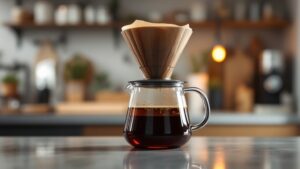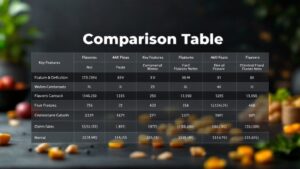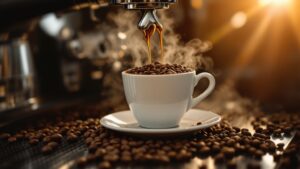Table of Contents
- Introduction
- Understanding the Variables
- Recommended Ratios for Different Brew Methods
- Experimentation and Fine-Tuning
- Conclusion
- Environmental and Safety Considerations
- Learning and Experimentation
- Conclusion
- Integrating Cupping into Your Routine
Coffee Brewing Methods and Tools Explored
Introduction
The Importance of Coffee Ratio
The quest for the perfect cup of coffee often feels like an elusive dream, but the truth is, achieving coffee nirvana is more science than art. At the heart of this science lies the coffee-to-water ratio – a seemingly simple concept that holds the key to unlocking the full potential of your beans. Neglecting this crucial element can lead to disappointing brews, regardless of the quality of your coffee or brewing equipment.
Why is the coffee-to-water ratio so important? Because it directly impacts the taste, strength, and overall quality of your final cup. Too little coffee, and you’re left with a weak, watery brew lacking in body and flavor. Too much coffee, and you’ll end up with a bitter, over-extracted concoction that overpowers the palate. Finding the right balance is essential for extracting the optimal flavors and aromas from your coffee grounds, resulting in a balanced, satisfying, and consistently delicious cup.
What This Guide Offers
This guide is your comprehensive roadmap to mastering the art of coffee ratios. We’ll delve deep into the science behind the numbers, providing you with a thorough understanding of how different ratios affect the final brew. Whether you’re a seasoned barista or a coffee novice, this guide will equip you with the knowledge and practical tips you need to achieve your ideal brew, every single time.
Coffee Brewing Methods Covered in This Guide
Inside, you’ll discover how to calculate coffee ratios with ease, explore the most popular ratios for various brewing methods, and learn how to adjust them to suit your personal preferences. We’ll also cover common mistakes to avoid and provide troubleshooting tips to help you overcome any challenges you might encounter along the way. By the end of this guide, you’ll be able to confidently experiment with different ratios, unlock the hidden potential of your favorite beans, and consistently brew coffee that delights your taste buds.
Understanding the Variables
Coffee-to-Water Ratio Explained
The coffee-to-water ratio is the foundational element in brewing a perfect cup of coffee. Simply put, it’s the proportion of coffee grounds you use relative to the amount of water. Think of it as the recipe for your coffee, dictating the strength and extraction of flavors from the beans.
This ratio is most commonly expressed in one of two ways: either as a ratio (e.g., 1:15) or as a weight-to-volume measurement (e.g., grams of coffee per liter of water). In the ratio format, 1:15 means one part coffee to fifteen parts water. So, for every 1 gram of coffee, you’d use 15 grams of water. The weight-to-volume format is more straightforward for some, specifying the exact amount of coffee (in grams) to use for each liter of water.
Factors Influencing the Ideal Ratio
While the coffee-to-water ratio provides a starting point, the “ideal” ratio isn’t a fixed number. It’s a dynamic value influenced by several factors, each playing a crucial role in the final taste of your brew. Understanding these factors allows you to tailor the ratio to your specific coffee and preferences.
Factors Influencing the Ideal Coffee-to-Water Ratio
The type of coffee bean you use significantly impacts the ideal ratio. Arabica and Robusta beans, the two most common varieties, differ considerably.
- Arabica vs. Robusta:Arabica beans are generally less dense and possess a more nuanced, often brighter, flavor profile compared to Robusta. Robusta beans, on the other hand, are denser, have a bolder, more bitter taste, and contain more caffeine. Due to these differences, you might find that Robusta beans require a slightly higher water ratio to mellow their intensity, while Arabica beans can often handle a lower ratio to highlight their complex flavors.
- Single-origin vs. Blends:Single-origin coffees, sourced from a specific farm or region, often have unique characteristics that require adjustments to the ratio. Blends, being a combination of different beans, aim for a more balanced and consistent flavor profile, often making them more forgiving and suitable for a wider range of ratios. Experimentation is key to unlocking the full potential of both single-origin and blended coffees.
The roast level of your coffee beans also plays a crucial role in determining the optimal coffee-to-water ratio. The roasting process develops different flavors and alters the bean’s structure, influencing how it interacts with water.
- Light Roast:Lightly roasted beans retain more acidity and often exhibit brighter, fruitier flavors. They may require a slightly lower water ratio to fully extract these delicate flavors and prevent an overly sour taste.
- Medium Roast:Medium roasts strike a balance between acidity and body, offering a versatile flavor profile. They generally work well with a standard coffee-to-water ratio, making them a good starting point for experimentation.
- Dark Roast:Darkly roasted beans have a bold, smoky, and sometimes bitter flavor. They tend to be more soluble, meaning they release their flavors more easily. Therefore, a higher water ratio is often recommended to prevent over-extraction and a harsh, bitter cup.
Grind size affects the surface area of the coffee grounds exposed to water, directly influencing the extraction rate. Using the wrong grind size can lead to under-extraction (sour, weak coffee) or over-extraction (bitter, astringent coffee).
- Coarse Grind:A coarse grind, resembling sea salt, is best suited for brewing methods like French Press, where the coffee grounds are immersed in water for a longer period. Using a coarse grind prevents over-extraction in this method. It is generally not suitable for espresso.
- Medium Grind:A medium grind, similar to sand, is ideal for drip coffee makers and pour-over methods. This grind size provides a balanced extraction, allowing for a flavorful and well-rounded cup.
- Fine Grind:A fine grind, resembling powdered sugar, is essential for espresso machines. The fine particles create resistance, allowing the pressurized water to extract a concentrated and intense shot of espresso. This method requires precise ratios and grind consistency.
Ultimately, the “ideal” coffee-to-water ratio is subjective and depends on your personal taste preferences. What one person finds perfectly balanced, another might find too strong or too weak.
- Strong Coffee:If you prefer a bolder, more intense flavor, try using a lower water ratio, such as 1:14 or even 1:12. This will result in a more concentrated brew.
- Milder Coffee:If you prefer a smoother, less intense flavor, opt for a higher water ratio, such as 1:17 or 1:18. This will dilute the coffee, creating a more mellow cup.
Don’t be afraid to experiment and adjust the ratio until you find the perfect balance that suits your palate. Keep notes on your adjustments and the resulting flavors to dial in your preferred coffee experience.
Recommended Ratios for Different Brew Methods
Recommended Coffee Brewing Ratios by Method
Recommended Ratios for Different Brew Methods
Drip Coffee
Drip coffee is a classic for a reason: it’s consistent and easy to make. To achieve that perfect balance of flavor, aim for a standard ratio of 1:15 to 1:17. This means using 1 gram of coffee for every 15 to 17 grams of water. This range allows for slight adjustments based on your coffee’s roast level and your personal taste.
For example, if you’re brewing a standard pot, try using 30 grams of coffee with 500 ml of water. This will provide a well-extracted and flavorful cup that’s neither too weak nor too strong. Remember, these ratios are starting points; feel free to experiment to find your sweet spot!
French Press
The French press is known for its full-bodied and rich brew, largely due to the immersion brewing method. Because of this, a slightly coarser grind and a different coffee-to-water ratio are required. A standard ratio for French press is 1:12 to 1:15. This means 1 gram of coffee for every 12 to 15 grams of water.
Consider using 60 grams of coffee with 720 ml of water for a larger French press. The longer brew time and the unfiltered nature of the French press amplify the coffee’s oils and flavors, resulting in a satisfying and robust cup. Adjust the ratio within the recommended range to fine-tune the intensity to your liking.
Pour Over (e.g., Hario V60)
Pour over methods, like the Hario V60, offer incredible control over the brewing process, allowing for a clean and nuanced cup. The recommended ratio for pour over is generally 1:15 to 1:16. This translates to 1 gram of coffee for every 15 to 16 grams of water.
Pour Over Brewing (e.g., Hario V60) Characteristics
For a single serving, try using 20 grams of coffee with 300 ml of water. The key with pour over is to saturate the grounds evenly and control the flow rate of the water. This ratio, combined with careful technique, will highlight the unique characteristics of your chosen coffee beans.
Espresso
Espresso is a concentrated and intense brew, requiring a much different ratio than other methods. The standard ratio for espresso falls within the range of 1:2 to 1:3. This signifies 1 gram of coffee for every 2 to 3 grams of liquid espresso.
Espresso Brewing Parameters
For instance, you might use 18 grams of finely ground coffee to produce 36-54 ml of espresso. The precise ratio and extraction time are crucial for achieving the perfect balance of sweetness, acidity, and bitterness that defines a well-made espresso shot. Dialing in your espresso machine and mastering your technique will allow you to pull shots that are rich, flavorful, and satisfying.
Experimentation and Fine-Tuning
Starting Point
Experimentation is key to finding your perfect coffee. Start with a 1:15 coffee-to-water ratio and adjust based on your taste, using coarser grinds and higher ratios to reduce bitterness, and finer grinds and lower ratios to combat acidity; detailed note-taking is essential for consistent results.
Once you understand the basic coffee-to-water ratio, the real fun begins: experimentation! Think of the 1:15 ratio (1 part coffee to 15 parts water) as your launchpad. It’s a solid starting point that generally yields a balanced and flavorful cup. From here, you can begin to tweak and adjust to perfectly match your taste preferences.
Don’t be afraid to deviate from the 1:15 baseline. Ultimately, the best ratio is the one that tastes best to you. The following subsections will guide you through some common adjustments you can make.
Adjusting for Strength
One of the easiest adjustments to make is to control the overall strength of your coffee. This is achieved by altering the amount of water used in relation to the amount of coffee grounds.
If you find your coffee is consistently too weak, even with a good extraction, try decreasing the amount of water you use. For example, move from a 1:15 ratio to a 1:14 ratio. This slightly higher concentration of coffee will result in a stronger brew. Conversely, if your coffee is too strong, increase the amount of water. A 1:16 or even 1:17 ratio will dilute the coffee and create a milder cup.
Adjusting for Bitterness/Acidity
Beyond strength, you can also manipulate the bitterness and acidity of your coffee through ratio adjustments, often in conjunction with grind size adjustments. These two characteristics are strongly influenced by the extraction process.
Adjusting Coffee Bitterness and Acidity
If your coffee is consistently too bitter, it’s likely being over-extracted. This means that too many compounds are being dissolved from the coffee grounds. To combat this, try a coarser grind and a slightly lower ratio, such as 1:16 or 1:17. The coarser grind reduces the surface area of the coffee, and the higher ratio dilutes the over-extracted elements.
On the other hand, if your coffee tastes too acidic or sour, it’s likely under-extracted. In this case, try a finer grind and a slightly higher ratio, such as 1:14 or even 1:13. The finer grind increases the surface area, allowing for more thorough extraction, and the lower ratio concentrates the extracted flavors.
The Importance of Note-Taking
As you experiment, the most crucial thing you can do is keep detailed notes. Coffee brewing is a science, and like any good scientist, you need to meticulously record your experiments and their results.
For each brew, write down the coffee-to-water ratio you used, the grind size (be as specific as possible, noting any settings on your grinder), the brew time, and any other relevant variables. Most importantly, document the taste of the coffee. What flavors do you detect? Is it balanced, too bitter, too acidic, too weak, or too strong? Use descriptive language to capture your experience.
Based on your notes, you can then make informed adjustments for your next brew. For example, if you found a 1:15 ratio to be too bitter with a medium grind, you might try a 1:16 ratio with a slightly coarser grind next time. Over time, you’ll develop a deep understanding of how different variables affect the final taste of your coffee and be able to consistently brew the perfect cup for your palate.
Conclusion
Conclusion
Recap of Key Points
We’ve journeyed through the essential elements of crafting the ideal pour-over coffee, and it’s time to consolidate our learnings. Remember, the coffee-to-water ratio is a cornerstone of the entire process. Too much water, and your coffee will be weak and underwhelming. Too little, and you risk a bitter, over-extracted brew. Finding that sweet spot, generally around a 1:15 to 1:17 ratio, is paramount.
Beyond the ratio, don’t underestimate the impact of your coffee beans themselves. The variety, roast level, and grind size all contribute significantly to the final flavor profile. A light roast will offer brighter, more acidic notes, while a dark roast delivers a bolder, more intense experience. The grind size must also match your chosen pour-over device; a grind that is too fine can lead to over-extraction and bitterness, while a coarse grind can result in a weak, under-extracted brew.
Finally, and perhaps most importantly, remember that experimentation is your greatest ally. Don’t be afraid to tweak variables, adjust your technique, and meticulously record your results. Every coffee bean is different, and what works perfectly for one may not work for another. Embrace the scientific method and refine your approach with each brew.
Final Thoughts
Achieving the perfect cup of pour-over coffee is not an overnight endeavor. It requires dedication, patience, and a willingness to learn from both your successes and your failures. With each attempt, you’ll gain a deeper understanding of the nuances of the process and develop a refined palate that can discern the subtle differences between brews.
Final Thoughts on Mastering Pour-Over Coffee: A Learning Journey
Ultimately, the journey to mastering pour-over coffee should be an enjoyable one. Embrace the ritual, savor the aromas, and appreciate the artistry involved in transforming humble coffee beans into a truly exceptional beverage. Don’t be discouraged by occasional missteps; view them as opportunities to learn and grow. The perfect cup is waiting to be discovered, and the path to finding it is filled with delightful exploration.
Environmental and Safety Considerations
Environmental Impact of Coffee Roasting
Coffee roasting, while a delightful process that awakens our senses, does have an environmental footprint that needs careful consideration. The primary concern revolves around the emissions produced during roasting. These emissions primarily consist of particulate matter (PM) and volatile organic compounds (VOCs), both of which can contribute to air pollution if not properly managed.
Particulate matter includes tiny particles that can be inhaled and pose respiratory health risks. VOCs are various gases released from the coffee beans during the roasting process, and some can contribute to smog formation. To mitigate these environmental impacts, roasters typically employ various emission control technologies.
The most common method involves ducting the emissions through a series of control devices. These often include cyclones, which use centrifugal force to separate particulate matter from the exhaust stream. More advanced systems incorporate thermal oxidizers or catalytic oxidizers. Thermal oxidizers use high temperatures to combust the pollutants, while catalytic oxidizers use a catalyst to facilitate the oxidation process at lower temperatures. These technologies significantly reduce the amount of PM and VOCs released into the atmosphere, making coffee roasting a more sustainable practice.
Safety Measures
Beyond environmental concerns, safety is paramount in any coffee roasting operation. The roasting process involves high temperatures and flammable organic materials, necessitating strict adherence to safety protocols to protect personnel and property.
Given the high temperatures involved, burns are a significant risk. Roasters should always wear appropriate personal protective equipment (PPE), including heat-resistant gloves and clothing, to minimize the risk of contact burns. Regular maintenance of roasting equipment is also crucial to prevent malfunctions that could lead to accidents.
Proper ventilation is essential to prevent the buildup of fumes and gases released during roasting. Inhaling these fumes can cause respiratory irritation and, in some cases, more severe health problems. A well-designed ventilation system will effectively remove fumes from the roasting area, ensuring a safe and comfortable working environment. Furthermore, gas detectors should be installed to monitor for carbon monoxide and other hazardous gases.
Fire safety is another critical aspect. Coffee chaff, a byproduct of roasting, is highly flammable. Roasters must implement strict housekeeping practices to prevent chaff accumulation and ensure that fire suppression systems, such as sprinklers and fire extinguishers, are readily available and properly maintained. Regular fire safety training for all personnel is also essential to ensure a swift and effective response in the event of a fire.
Learning and Experimentation
Learning and Experimentation
Tips for Improving Your Roasting Skills
Roasting coffee at home is a journey of continuous learning and refinement. It’s not just about following a recipe; it’s about understanding the nuances of the beans and how they react to heat. To truly elevate your roasting skills, meticulous record-keeping is essential.
Document every roast, noting the type of bean, the date, the ambient temperature, and the specific details of your roasting profile. This includes the temperature at various stages, the time elapsed, and any observations you make during the process, such as the aroma or the sounds of cracking. Most importantly, record the outcome – how the coffee tastes. Over time, these records will become invaluable, allowing you to identify patterns and understand how different variables affect the final cup.
Experimentation is the key to finding your personal roast style. Don’t be afraid to deviate from established guidelines and try different approaches. Adjust your charge temperature, airflow, or roast time to see how it impacts the flavor profile. Perhaps you prefer a longer, slower roast for a smoother, more developed flavor, or a faster, hotter roast to highlight the acidity and brightness. The possibilities are endless, and the only way to discover your preferences is through experimentation.
Finally, remember that patience and persistence are crucial. Roasting is a skill that takes time to master. There will be batches that don’t turn out as expected, and that’s perfectly normal. Don’t get discouraged by setbacks. Instead, view them as learning opportunities. Analyze what went wrong, adjust your approach, and try again. With dedication and a willingness to learn, you’ll gradually develop a deeper understanding of the roasting process and consistently produce exceptional coffee.
Resources for Further Learning
While hands-on experience is invaluable, supplementing your learning with external resources can significantly accelerate your progress. Consider attending roasting classes, such as those offered by Current Crop Roasting. These classes provide structured learning environments where you can learn from experienced roasters, receive personalized feedback, and gain a deeper understanding of the technical aspects of roasting.
Online forums and communities are also excellent resources for connecting with other home roasters, sharing experiences, and asking questions. Platforms like Reddit’s r/roasting or Home-Barista.com host active communities where you can find valuable insights and advice from fellow enthusiasts. Engaging in these communities can provide a sense of camaraderie and support as you navigate your roasting journey.
Finally, don’t underestimate the power of books and articles on coffee roasting. There are numerous resources available that delve into the science and art of roasting, covering topics such as bean physiology, roast profile design, and troubleshooting common issues. Some popular titles include “The Coffee Roaster’s Companion” by Scott Rao and “Home Coffee Roasting: Romance and বিজ্ঞান” by Kenneth Davids. Reading these resources can provide a solid theoretical foundation to complement your practical experience and deepen your understanding of the roasting process.
Conclusion
Recap of Key Concepts
Throughout this guide, we’ve journeyed through the intricate world of coffee roasting, uncovering the vital elements that contribute to a perfect cup. We’ve emphasized the importance of meticulous bean selection, understanding that the quality of your green beans directly influences the final roast. We then delved into the roasting process itself, exploring the various stages and transformations that occur as heat is applied.
Key Characteristics of Coffee Roasting Concepts
Understanding roast levels – from light to dark – is crucial, as each level unlocks different flavor profiles and characteristics within the bean. Remember that mastering coffee roasting is a blend of art and science. The science provides the framework and understanding of the chemical reactions, while the art allows for intuition, experimentation, and the development of a unique roasting style.
Final Thoughts
The world of coffee roasting is vast and ever-evolving. We encourage you to take the knowledge you’ve gained here and experiment! Try different bean origins, adjust your roasting profiles, and meticulously document your results. Don’t be afraid to make mistakes; they are valuable learning opportunities that will ultimately refine your skills.
The journey of continuous learning is what makes coffee roasting so rewarding. There’s always something new to discover, a different technique to try, or a subtle nuance to explore. Embrace the process, enjoy the aroma, and savor the satisfaction of crafting your own exceptional coffee.
Integrating Cupping into Your Routine
Integrating Cupping into Your Routine
Enhancing Appreciation of Coffee
Incorporating coffee cupping into your regular routine is a fantastic way to deepen your appreciation for the nuances and complexities of this beloved beverage. By practicing the techniques involved in cupping, you’ll train your senses to discern subtle differences in aroma, flavor, and body that you might otherwise miss.
Techniques and Characteristics for Enhancing Coffee Appreciation
The cupping process encourages you to engage with coffee in a more deliberate and focused manner. It teaches you to smell the coffee grounds in a specific way, identifying various aromatic compounds. Similarly, the tasting process involves carefully slurping the coffee to aerate it and distribute it across your palate, allowing you to detect a wider range of flavors. This practiced approach cultivates a heightened awareness of the sensory characteristics of coffee, transforming your daily cup into a more enriching experience.
Personal Enjoyment and Connection
Beyond simply identifying flavors and aromas, cupping can significantly enhance your personal enjoyment of and connection with coffee. By taking the time to intentionally evaluate each coffee, you create a more mindful and engaging ritual.





